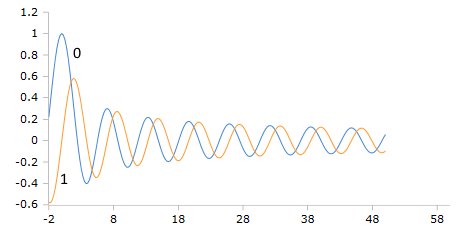Calculate Bessel-J Function
Online calculator for the Bessel function Jᵥ(z) of the first kind - Classical oscillating cylindrical function for wave processes
Bessel-J Function Calculator
Classical Bessel Function
The Jᵥ(z) or classical Bessel function shows oscillating behavior and is the foundation of all cylindrical functions.
Bessel-J Function Curve
Mouse pointer on the graph shows the values.
The classical Bessel function shows characteristic oscillations with damping amplitude.
Characteristic oscillations of the Bessel-J function
The classical Bessel function is the original and most important cylindrical function:
- Periodic oscillation: Jᵥ(z) oscillates for large z
- Damping amplitude: Amplitude ~ 1/√z
- Infinite zeros: Regularly distributed zeros
- Fundamental importance: Basis of all other Bessel functions
- Physical relevance: Direct solution of the wave equation
- Asymptotics: Jᵥ(z) ~ √(2/πz) cos(z - πν/2 - π/4)
Fundamental solution in cylindrical coordinates
The Bessel-J function is the fundamental solution of the Bessel differential equation:
Bessel Differential Equation
Fundamental ODE of cylindrical functions
General Solution
J and Y form a fundamental solution system
Formulas for the Bessel-J Function
Series Expansion
Fundamental power series expansion
Symmetry Relation
For integer ν
Asymptotic Form
For large z (leading term of asymptotic expansion)
Recurrence Formulas
Recurrence relations for efficient computation
Integral Representation
For integer order n (Bessel integral)
Generating Function
Laurent expansion of the generating function
Special Values
Important Values
Symmetry Properties
For integer n
Behavior at z = 0
Limiting behavior at origin
Zeros of J₀
First zeros of the fundamental mode
Application Areas
Membrane vibrations, waveguides, acoustic resonators, antenna theory.
Bessel-J Oscillation Pattern

Bessel-J Functions (Order 0,1)
The classical Bessel functions show characteristic oscillations with decreasing amplitude proportional to 1/√z for large arguments.
Characteristic Properties
- J₀(z) starts at 1, first zero at z ≈ 2.405
- J₁(z) starts at 0, first zero at z ≈ 3.832
- Asymptotically: ~ √(2/πz) cos(...)
- Oscillation period ≈ 2π for large z
Detailed Description of the Bessel-J Function
Mathematical Definition
The classical Bessel function Jᵥ(z) is the fundamental solution of the Bessel differential equation. It was originally developed by Friedrich Bessel during the analysis of planetary motion and is today the most important cylindrical function.
Using the Calculator
Enter the order ν (integer) and the argument z (positive real number). The graph stretch parameter controls the X-axis scaling for optimal oscillation display.
Historical Background
Friedrich Bessel (1784-1846) originally developed these functions for astronomical calculations. The functions proved to be fundamental for all problems with cylindrical symmetry and are today indispensable in physics and engineering.
Properties and Applications
Physical Applications
- Circular membrane vibrations (drum head, loudspeakers)
- Electromagnetic waves in cylindrical waveguides
- Acoustic resonators and cavity resonators
- Diffraction of electromagnetic waves at cylinders
Mathematical Properties
- Oscillating behavior with damping amplitude
- Infinitely many zeros for ν ≥ 0
- Orthogonality relations on intervals
- Complete function system for cylindrical problems
Numerical Aspects
- Stability: Numerically stable for all real z ≥ 0
- Algorithms: Different methods depending on z range
- Accuracy: High precision through optimized implementations
- Efficiency: Recurrence formulas for adjacent orders
Interesting Facts
- J₀(z) describes the fundamental vibration of a circular membrane
- The zeros determine resonance frequencies of cylindrical cavities
- Bessel functions are essential for the Fourier-Bessel transform
- They enable the solution of the wave equation in cylindrical coordinates
Calculation Examples and Oscillation Behavior
Small Argument
z = 1:
J₀(1) ≈ 0.765
J₁(1) ≈ 0.440
First Zero
z ≈ 2.405:
J₀(2.405) ≈ 0
First zero of J₀
Large Argument
z = 20:
J₀(20) ≈ 0.167
Asymptotic behavior
Physical Applications in Detail
Membrane Vibrations
Circular membrane:
u(r,φ,t) = J_m(k·r) cos(mφ) cos(ωt)
Resonances at J_m(k·R) = 0
Example: Drum head with radius R has fundamental frequency at k·R = 2.405.
Electromagnetic Waves
Cylindrical waveguides:
E_z ∝ J_m(k_c·r) e^(imφ) e^(ikz)
Cutoff at J_m(k_c·a) = 0
Example: Coaxial cables and waveguides use these modes.
Zeros and Special Properties
Zeros of First Orders
J₀(z) zeros:
2.405, 5.520, 8.654, 11.792, 14.931, ...
J₁(z) zeros:
3.832, 7.016, 10.173, 13.324, 16.471, ...
Asymptotics: Zeros follow αₙ ≈ (n + ν/2 - 1/4)π for large n.
Asymptotic Behavior
For large z:
Jᵥ(z) ~ √(2/πz) cos(z - νπ/2 - π/4)
Amplitude ~ 1/√z, period ≈ 2π
Properties: Damped oscillation with constant frequency.
Orthogonality and Fourier Series
Orthogonality Relation
On interval [0,R]:
for m ≠ n
Significance: Enables Fourier-Bessel expansions.
Fourier-Bessel Series
Expansion of function f(r):
with coefficients A_n
Application: Solution of boundary value problems in cylinders.
Numerical Computation and Algorithms
Computation Methods
- Series Expansion: For small |z| ≤ 8
- Asymptotic Expansion: For large |z| ≥ 25
- Recurrence Relations: For medium ranges
- Chebyshev Approximation: For transition regions
Software Implementations
- GNU GSL: High-precision implementations
- Boost Math: C++ template library
- SciPy: Python scipy.special.jv
- MATLAB: Built-in besselj function
|
|